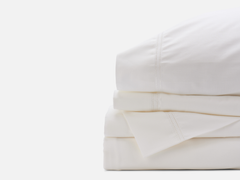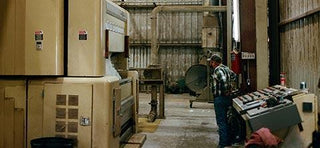Ever wondered what it looks like to go from farm to fabric? Well, there are a lot of steps in between.
Our process starts at the ground level. So every fall, we harvest acres upon acres of the beautiful upland cotton we know and love. From there, we take the round modules of cotton weighing approximately 5,000 lbs a piece and feed them one by one into our cotton gin.
At Yeager Gin Co., we custom gin our fiber to ensure our cotton is clean and pure by OUR standards! Every bale of cotton is tagged and a sample is taken to the classing offices to be graded. Once our grades come back, we select only the best bales of cotton to go into our sheets, towels, and quilts. THAT, my friends, is just the start of the Red Land Cotton difference!
Watch the video below and follow us into the field as we harvest our cotton, and take a glimpse inside our cotton gin where the magic happens! Then, read on to get the step by step guide to how the ginning process works at Red Land Cotton!
Step By Step:
1. Harvest
Beginning in late September and early October, we begin harvesting our cotton crop. Typically our cotton covers approximately 4k acres of land. We run three John Deere cotton pickers during the season and are typically finished with Harvest by mid-November.
Each cotton picker creates it's own round bale of cotton and deposits the round bale in the field once it is fully formed. This is a HUGE development from the old days of using the massive module builders! BUT, anyone who has jumped and played in a large module of cotton knows this new technology takes away some fun too.

2. To The Cotton Gin
Each 5,000lb bale is picked up, placed on an 18 wheeler and driven to the gin yard. Each bale is marked by the field it was picked from. We have fun names for our different fields. For example, we have the Fairfield, Abbey Church, Baker Lane, Cottontown, 6th Street, Egypt... and the list goes on and on. You see, our fields run across all of Lawrence and Colbert counties, so we had to come up with some unique ways to remember which field we are referring to in conversation. The bales stay out in the gin yard until the gin fires up around November 20th!

3. Feeding The Bales
Each bale is individually picked up by a heavy piece of machinery and placed onto the conveyor that feeds into the gin. Slowly, the bales are fed into the inner plumbing of the gin and the first real stop is the gin stand.

4. The Gin Stand
The gin stand is the heart of the gin. It's the souped-up version of Eli Whitney's invention several years ago. Essentially, the seed is removed from the cotton fiber and filtered out. From there, the seed is deposited into storage. To hear more about what we do with our cotton seed during the winter, feel free to watch this video.

5. Lint Cleaning
The cotton that flows through the gin at Yeager Gin Co. is cleaned not once, but twice to further purify the cotton fiber. This just means less leaf, stem, and trash that makes its way into the final product.

6. Bale Press
The twice cleaned fiber then makes its way to the press! Approximately 500lbs of cotton lint are pressed into each uniform rectangular bale. The fiber is pressed down, ties secure the lint in place and then the press removes the pressure, allowing the cotton to fluff back up again before it lands on a cart. A sample is then taken from the bale. This sample is tagged to match the bale it came from and is sent to the cotton classing office to receive a grade. To read more about how cotton is classified, read here.

7. Tags, Bags and Storage
Once the sample is pulled from the bale, it is bagged, tagged and sent to storage. We wait for our grades to come back on each bale before we select the cotton that goes to South Carolina to be spun into yarn for our bedding and bath towels.

Our ginning process is just one of the unique steps we take to ensure a pure product is delivered to you! We love what we do and we are thankful to have an opportunity to share our farm with you!








